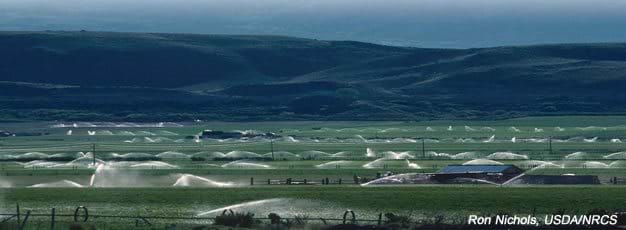Agriculture Dominates Freshwater Use in the U.S.

Irrigation made the desert bloom in the West and improved crop alternatives in the East. The less than 20 percent of cropland that is irrigated produces almost half of all crop sales. But this intensive, high-yielding agriculture takes many inputs—fertilizer, chemicals, management, and, especially, water.
Agriculture accounted for over 80 percent of the Nation’s consumptive water use over 1960-95—greater than any other sector, both in total and as a share of water withdrawn. Water use can be measured in terms of withdrawals (total water withdrawn from the environment) or consumptive use—the difference between withdrawals and the amount of water returned through return flows and runoff. While the thermoelectric sector withdraws almost as much freshwater as agriculture (152 versus 159 million acre-feet in 2000), most water diverted to cool thermoelectric power plants is returned to lakes, rivers, and streams. On the other hand, most agricultural water use is for irrigation, and that water is mostly taken up by crops, with relatively little returning to the immediate water environment (streams and aquifers) for reuse.
Most agricultural water withdrawals occur in the arid Western States where irrigated production is concentrated. In 2000, about 85 percent of total agricultural withdrawals occurred in a 19-State area encompassing the Plains, Mountain, and Pacific regions. In the Mountain region, over 90 percent of the water withdrawn is used by agriculture, almost all (96 percent) for irrigation. Nationally, irrigation is the dominant agricultural water use, but water withdrawn for livestock and aquaculture production (including fish hatcheries) accounts for almost 20 percent of withdrawals in the North-Central and Eastern States. Even in these more humid States, irrigation is the dominant agricultural water use.
Whether water is returned to streams and aquifers or not, water losses, runoff, return flows, and groundwater recharge can have varying effects on the environment. For example, water that is diverted for cooling purposes is typically returned at a higher temperature, which may harm the environment. Environmental impacts can occur from surface-water withdrawals that reduce streamflow. In areas where streamflow is limited, it is usually also needed for riparian systems, fish habitat, groundwater recharge, wetlands preservation, and other extractive uses. When groundwater withdrawals exceed natural rates of aquifer recharge, environmental consequences of groundwater extraction can include land subsidence and reduced flow from natural springs, which reduces surface-water availability.
Agricultural Resources and Environmental Indicators, 2006 Edition, by Keith Wiebe and Noel Gollehon, USDA, Economic Research Service, July 2006


